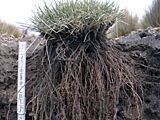Functional strategies in clonal plants
Morphological types must not necessarily differ in their functional significance. Clonal plants are characterized by growth strategies with different functional significance. Following Stearns (1976) a "strategy" is defined as a set of co-adapted traits designed to solve particular ecological problems.
The key factors determining a clonal growth strategy are:
- Growth form or clonal morphology ("phalanx" vs. "guerrilla" type)
- The extent of structural and physiological integration.
- The possibility to respond to environmental cues by changes in morphology and physiology ("phenotypic plasticity").



